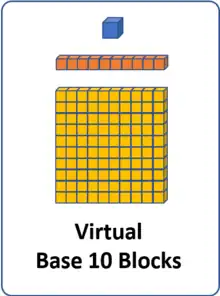Virtual manipulatives for mathematics
Virtual math manipulatives are visual representations of concrete math manipulatives. They are accessed through a variety of websites and apps.[1] Virtual math manipulatives are modeled after concrete math manipulatives that are commonly used in classrooms to physically represent mathematical concepts and support student understanding of mathematical concepts.[2][3]

The most common manipulatives include: base ten blocks, coins, blocks, tangrams, rulers, fraction bars, algebra tiles, geoboards, geometric plane, and solids figures.
Advantages and Disadvantages
Classroom studies were conducted which investigated virtual manipulatives. The studies compare virtual manipulatives to concrete manipulatives and discuss some of its implications.[4]
Advantages
The observed learning benefits of virtual manipulatives includes providing detailed instruction and prompt evaluation for assigned tasks. Students were seen to apprehend concepts better, since this style of learning appeals to digital natives. Virtual manipulatives can often provide explicit connections between visual and symbolic representations. Moreover, it signals to students when they’ve made a mistake, which encourages them to reflect and revisit answers accordingly. Lastly, virtual manipulatives prove to be more convenient because they are likely more accessible at home than concrete manipulatives.[4]
Disadvantages
In comparison to concrete manipulatives, virtual manipulatives lack opportunities for learners and educators to physically touch objects, which is an immense disadvantage for kinesthetic learners. Educators are unable to follow the learners thought process, making it difficult to understand their comprehension levels. Moreover, virtual manipulatives are a form of digital learning. One of the drawbacks of digital learning is an increase in computer dependence as it limits students learning abilities. It does not encourage learners to independently find answers and locate their mistakes. Teaching preferences often include guiding students through answers only when they are unable to grasp content or find difficulty comprehending questions. Lastly, Hunts et al. states that learning mathematics through the use of virtual manipulatives feels more like a "do" experience rather than learn and explore learning experience.[4]
Special Education
Although relatively new, virtual manipulatives can support learning mathematics for all students, which include those with learning disabilities and ELL learners. If they are used wisely, virtual manipulatives can provide students with opportunities for guided discovery, which can help them to build a better understanding of mathematical concepts and ultimately exhibit measurable learning skills. Virtual manipulatives can be included into the general academic curriculum as assistive technology and should not just be used for its novelty.[5]
Studies [6][7][5] on the use of virtual manipulatives in mathematics for students with learning disabilities advocate the use of virtual manipulatives in mathematics for students with learning disabilities as it can favour:
Practicality: Virtual manipulatives help where physical manipulation is not physically possible, it offers opportunities for repeated practice, it is accessible (i.e. accessed by phones, ipads, etc.) and cost-effective (i.e. free or low cost).[6][5]
Student independence: Virtual manipulatives allow for instant feedback and built-in scaffolding,[6] which allows for individualized instruction and for students to build on their learning skills independently and effectively, without the presence of a teacher. Virtual manipulatives offer students the opportunity to double-check their work and have visual representations of mathematical problems to solve.[7]
Learning beyond the classroom: Virtual manipulatives provide opportunity for learning outside the classroom, as it is transportable.[6][7] It can also allow students to share their results with their teacher beyond the classroom.
Considerations for Stakeholders
To effectively use virtual manipulatives in mathematics, stakeholders should: assess the severity of student’s learning and cognitive disabilities as well as their needs prior to implementing virtual manipulatives;[6] evaluate mathematical applications using rubrics for students with learning disabilities to validate the effectiveness of the application in connection with the learning goals;[6] consider the lack of or limited access to technology and funding in some schools;[5] and evaluate student engagement to ensure that students are actively learning and achieving learning goals through the use of virtual manipulatives.
References
- Moyer, P.S. (2002). "What are Virtual Manipulatives?". Teaching Children Mathematics. 8 (6): 372–377. doi:10.5951/TCM.8.6.0372.
- Carbonneau, K.J. (2013). "A meta-analysis of the efficacy of teaching mathematics with concrete manipulatives". Journal of Educational Psychology. 105 (2): 380–400. doi:10.1037/a0031084.
- Silva R., Costa C., Martins, F. (2021). "Using Mathematical Modelling and Virtual Manipulatives to Teach Elementary Mathematics". Technology and Innovation in Learning, Teaching and Education. Communications in Computer and Information Science. 1884: 75–89. doi:10.1007/978-3-030-73988-1_6. ISBN 978-3-030-73987-4. S2CID 234959877 – via https://doi.org/10.1007/978-3-030-73988-1_6.
{{cite journal}}: External link in|via= - Hunt, Annita W. (2008-01-01). "Virtual vs. Concrete Manipulatives in Mathematics Teacher Education: A Call for Research". Proceedings of the Annual Meeting of the Georgia Association of Mathematics Teacher Educators. 2 (1). doi:10.20429/gamte.2008.020103. ISSN 2692-7721.
- Bouck, Emily C.; Anderson, Rubia D.; Long, Holly; Sprick, Jessica (2021-02-26). "Manipulative-Based Instructional Sequences in Mathematics for Students With Disabilities". TEACHING Exceptional Children. 54 (3): 178–190. doi:10.1177/0040059921994599. ISSN 0040-0599. S2CID 233907400.
- Satsangi, Rajiv; Miller, Bridget (2017). "The Case for Adopting Virtual Manipulatives in Mathematics Education for Students with Disabilities". Preventing School Failure. 61 (4): 303–310. doi:10.1080/1045988X.2016.1275505. ISSN 1045-988X. S2CID 152099008.
- Satsangi, Rajiv; Hammer, R.; Evmenova, A. (2018). "Teaching Multistep Equations with Virtual Manipulatives to Secondary Students with Learning Disabilities". Learning Disabilities Research & Practice. 33 (2): 99–111. doi:10.1111/ldrp.12166. S2CID 149871579.
- Moyer, P. S., Bolyard, J. J., & Spikell, M. A. (2000). What are virtual manipulatives? [Online]. Teaching Children Mathematics, 8(6), 372-377. Available:
- Moyer, P. S., Niezgoda, D., & Stanley, J. (2005). Young children's use of virtual manipulatives and other forms of mathematical representations. In W. J. Masalaski & P. C. Elliot (Eds.), Technology-Supported Mathematics Learning Environments (pp. 17–34). Reston, VA: National Council of Teachers of Mathematics.
- Ortiz, Enrique (2017).Pre-service teachers’ ability to identify and implement cognitive levels in mathematics learning. Issues in the Undergraduate Mathematics Preparation of School Teachers (IUMPST): The Journal (Technology), 3, pp. 1–14. Retrieved from http://www.k-12prep.math.ttu.edu/journal/3.technology/volume.shtml pdf: http://www.k-12prep.math.ttu.edu/journal/3.technology/ortiz01/article.pdf
- Ortiz, Enrique, Eisenreich, Heidi & Tapp, Laura (2019). Physical and virtual manipulative framework conceptions of undergraduate pre-service teachers. International Journal for Mathematics Teaching and Learning, 20(1), 62-84. Retrieved from https://www.cimt.org.uk/ijmtl/index.php/IJMTL/article/view/116